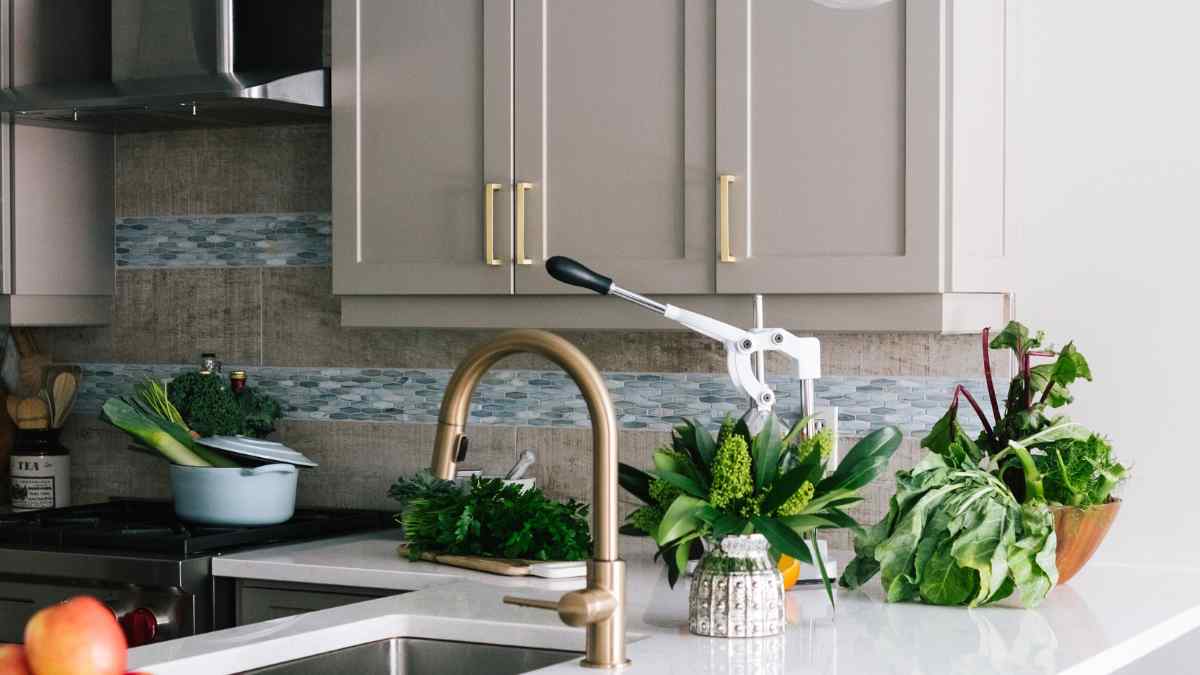
We may earn money or products from the companies mentioned in this post.
Elevate your kitchen décor and bring the outdoors in with lush Greenery Above Kitchen Cabinets. This simple yet striking design adds a touch of freshness and vibrancy to any kitchen space.
Ever felt like your kitchen needs an extra pop of life? A simple trick to elevate your kitchen décor and bring the outdoors in is hanging greenery above your kitchen cabinets. This striking yet low-maintenance design adds a refreshing touch of nature that will make you feel like you’re cooking in a secret garden hideaway. Forget about redoing cabinets or splurging on expensive backsplashes.
All you need are a few planters, some trailing vines, and a couple of hooks to instantly transform your kitchen into an airy oasis. Best of all, greenery above kitchen cabinets works with any style from modern minimalism to cozy farmhouse. Ready to see your kitchen in a whole new light? Read on to learn how adding greenery above your kitchen cabinets can make a big impact with little effort. Your kitchen will thank you for the extra dose of life and vibrancy.
Benefits of Adding Plants Above Kitchen Cabinets
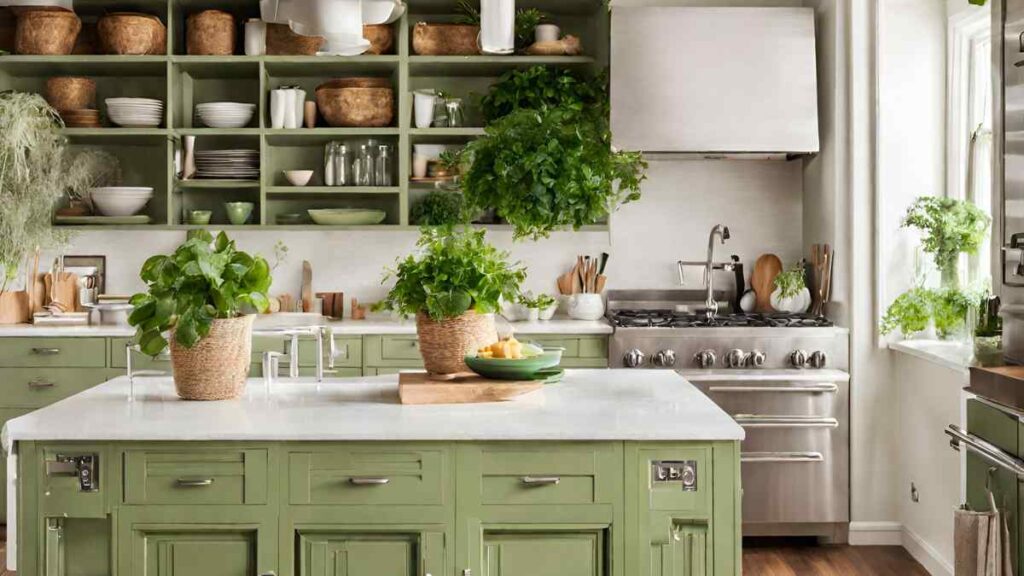
Adding greenery above your kitchen cabinets does wonders for your space. Here are some of the benefits:
Improved Air Quality
Houseplants naturally filter the air in your home, absorbing toxins and producing oxygen. Having plants in your kitchen, the heart of the home, means fresher, cleaner air where you cook and eat. Their lush leaves also add humidity which is great in a space prone to steam and smells.
Enhanced Esthetic
Trailing plants, ferns, ivy, and herbs dangling from above soften the hard edges of cabinets and open shelving. Their verdant foliage helps create a relaxed, natural vibe in an area typically dominated by stark surfaces. Strategically placed lighting highlighting the greenery casts an enchanting glow over the entire kitchen.
Easy Access to Fresh Herbs
For cooks, having pots of chives, thyme, mint, basil, and rosemary right above the prep area is ideal. Just reach up and snip what you need to instantly enhance a dish with fresh-from-the-source flavor. Place a tray below to catch any dropped leaves or drips.
Simple Installation
Securing planters above cabinets is surprisingly straightforward. You can find wall mounts, brackets, and rail systems at your local garden center that attach easily and hold a surprising amount of weight. For a renter-friendly option, adhesive hooks stick directly to the underside of cabinets to hang small planters.
With the many advantages of bringing plants to this often overlooked spot, adding greenery above your kitchen cabinets is a simple change that makes a big impact. Infusing nature into the place where you nourish both body and soul creates the perfect blend of form and function. Your kitchen and all who enjoy it will thrive under the verdant veil of trailing vines and fragrant herbs.
Choosing the Right Plants for Your Kitchen
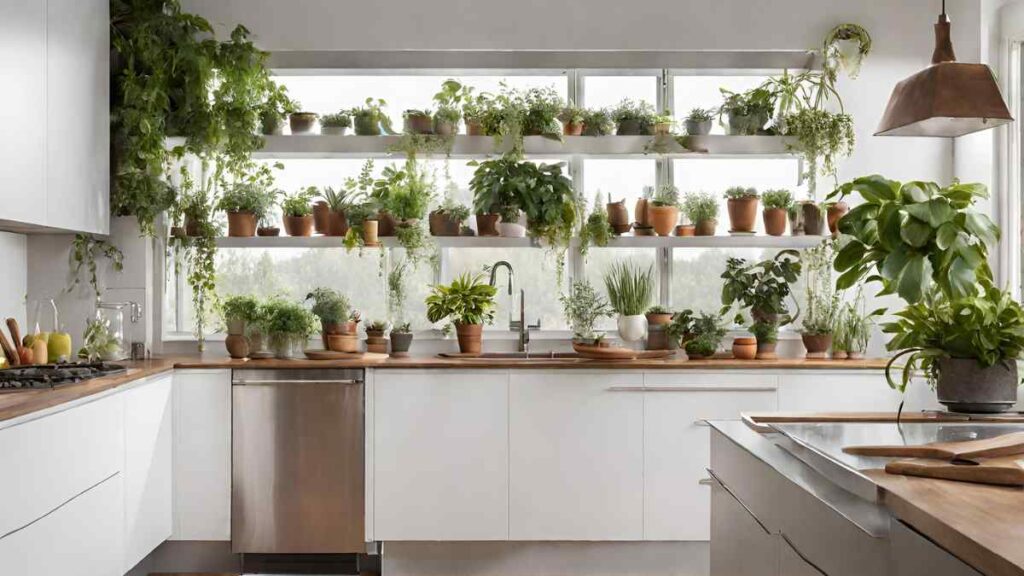
When choosing plants above your kitchen cabinets, consider the light conditions and temperature in your space. Some great options include:
- Pothos plants: With their trailing vines and variegated leaves, pothos plants make a stunning statement above cabinets. They do well in medium to low light and average room temperatures. Just make sure to water when the top inch of soil is dry.
- Spider plants: Spider plants are easy to care for and able to tolerate some neglect. Their long, strappy leaves will cascade down, creating a waterfall effect. Spider plants do best in medium light and average temperatures. Allow the top of the pot to dry out between waterings.
- Chinese evergreen: This popular houseplant comes in a variety of leaf shapes, sizes, and colors. Chinese evergreen can tolerate low light but prefer medium light and average room temperatures. Water when the top of the potting mix is dry. Its exotic, tropical leaves will make your kitchen feel like a lush jungle oasis.
- Philodendrons: Heartleaf philodendrons have beautiful heart-shaped leaves and trailing vines that will tumble down from above your cabinets. They can tolerate low light but prefer medium light and do best in average room temperatures. Water when the top inch of soil is dry.
By choosing plants that match your kitchen’s conditions, you’ll have a verdant display that thrives for years to come. Regular pruning and shaping will keep your hanging garden looking full and encourage new healthy growth. With the right care and maintenance, greenery above your kitchen cabinets can transform the space into a natural and calming retreat.
Hanging Plants Above Cabinets Without Damaging Walls
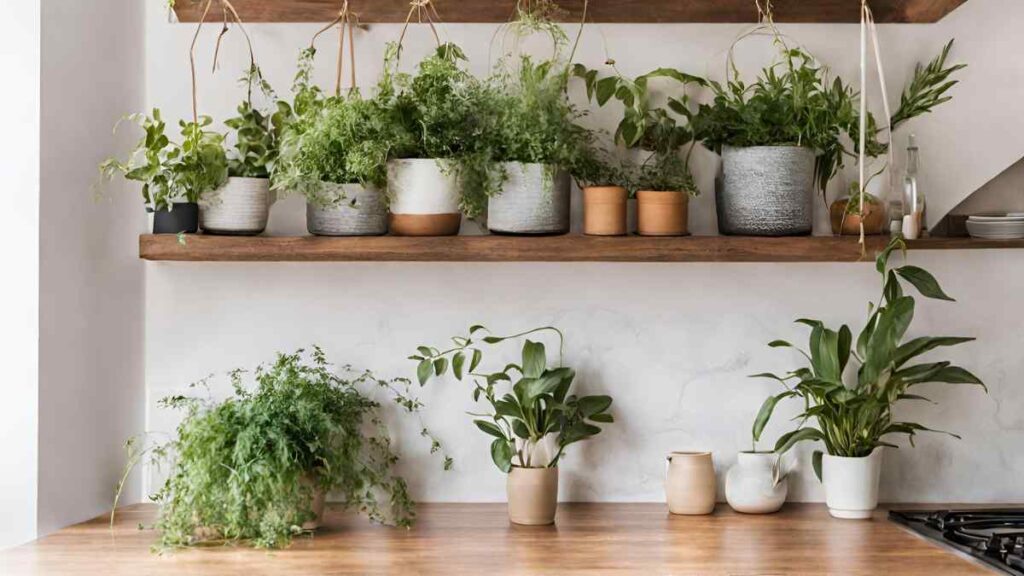
Hanging plants are a great way to bring nature indoors without damaging your walls. There are a few easy ways to hang plants above your kitchen cabinets without putting holes in the wall.
macrame plant hangers
Macrame plant hangers are decorative knotted cords that you can attach to your ceiling to hang plants. You can find macrame hangers in different styles, sizes, and cord materials to suit your space. Attach the top of the hanger to your ceiling using wall anchors and screws, or adhesive wall hooks. The weight of the plant will keep the hanger securely in place. This is an ideal option if you’re renting or want to avoid wall damage.
ceiling hooks
Adhesive or magnetic ceiling hooks are another hole-free option for hanging plants above cabinets. Look for hooks that can hold at least 5 to 10 pounds for most small to medium-sized plants. Clean and rough up the area where you want to place the hooks, then press firmly to adhere to the ceiling. The adhesive on these hooks is strong enough to hold plants but can be removed without damage when needed.
hanging rails
Hanging rails are metal or wooden beams that attach to your ceiling to hang multiple plants at once. You can find basic rails that span the width of your cabinets, or get creative with corner pieces to make an arch or grid shape. Attach the rails directly to ceiling joists for maximum support. This makes a great statement piece and is ideal if you have a collection of plants to display.
Using any of these methods, you can easily elevate your kitchen décor with lush greenery above your cabinets. Start with just one or two plants to keep it simple, then build your indoor garden from there. The fresh, natural ambiance these hanging plants create will make your kitchen feel like an oasis. Your space will be bursting with life in no time!
Arrangement Ideas for Greenery Above Cabinets
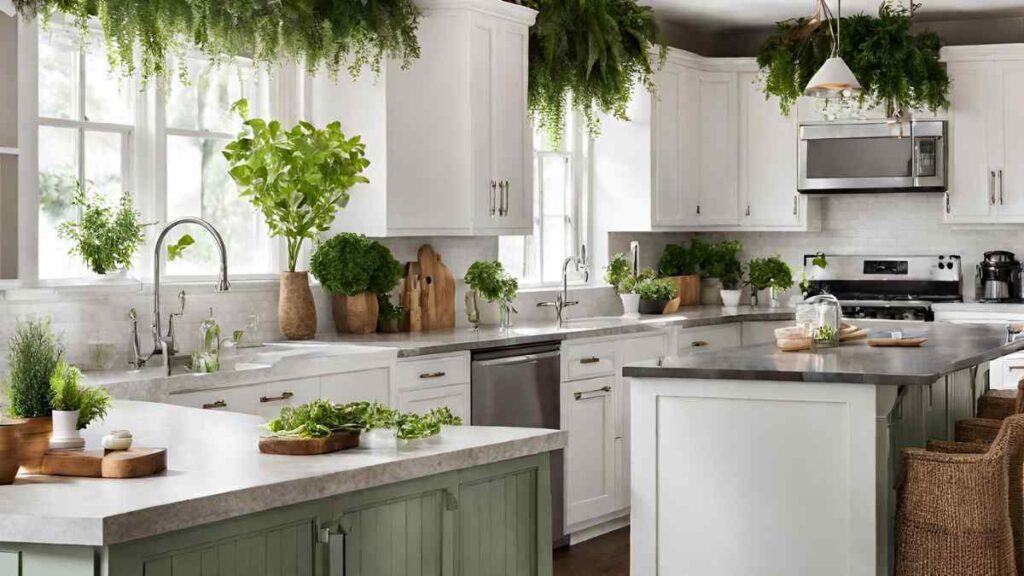
Arranging greenery above your kitchen cabinets helps bring nature indoors and adds visual interest to the space. Here are some ideas to get you started:
Asymmetrical cluster
Group several small plants together in an asymmetrical cluster off to one side of the cabinets. This creates a casual, organic look. Some great options for clusters include:
- Small succulents like echeverias, crassulas, and haworthias. Their sculptural shapes complement each other.
- Air plants. Their spiky leaves provide a nice texture. Simply attach them to wood boards or in small planters and arrange them on top of the cabinets.
- Herb starts or small houseplants. Things like rosemary, thyme, pothos, or Chinese evergreen work well for clusters.
Single statement piece
For a simple but bold look, choose one large plant and place it in the center above the cabinets. Some excellent choices include:
- Fiddle leaf fig. Its big, dramatic leaves make a stunning statement.
- Monstera deliciosa. The split leaves of this tropical plant are eye-catching.
- Bird of paradise. The unique flowers of this plant, which resemble tropical birds, will become a focal point.
Garland
For a whimsical feel, string up natural elements to create a garland over the cabinets:
- Eucalyptus branches. Their aromatic silver-green leaves will freshen up the space. Simply gather a few branches, wire them together, and attach them to the ceiling.
- Succulents. Remove a few leaves from succulents like echeveria and string them onto twine or fishing line for a colorful garland. Let the cut ends dry out for a day or two before stringing.
Whether you prefer a minimal cluster, a bold statement piece, or a whimsical garland, adding greenery over kitchen cabinets is an easy way to bring nature to your home. Try one idea or combine a few for an inviting display that fits your personal style. Your kitchen will feel fresher and more vibrant in no time.
Caring for Your Kitchen Cabinet Plants
Now that you have your lush greenery installed above your kitchen cabinets, it’s important to properly care for your new plant companions. Keeping them healthy and thriving is key to enjoying their beauty for years to come.
Watering
Water your cabinet plants regularly to keep the soil moderately moist. As a general rule, check the top few inches of soil with your finger before watering. If it’s dry to the touch, it’s probably time for a drink. Thoroughly drench the soil until water flows out the drainage holes, then empty the excess water from the saucer under the pot. Never leave your plants sitting in water, as this can lead to root rot.
Lighting
While most household plants can survive in low to medium light, more light is better. Place your cabinet plants near a window that gets lots of bright, indirect light during the day. East or west-facing windows are ideal. If natural light is limited in your kitchen, consider supplementing with artificial plant lights. Lack of adequate light is a common reason why cabinet plants fail to thrive.
Fertilizing
During the growing season, feed your cabinet plants with a balanced, all-purpose fertilizer once a month. Use a fertilizer with equal parts nitrogen, phosphorus, and potassium, such as 10-10-10. Dilute to 1/2 the recommended strength to avoid fertilizer burn on the leaves. Fertilizer will provide the nutrients your plants need to produce healthy new growth. In the fall and winter, reduce or stop feeding when growth slows down.
Repotting
Watch your cabinet plants closely for signs they are becoming pot-bound, such as roots protruding from the drainage holes or water running straight through the pot. When necessary, move up one size and replant with fresh, well-draining soil. Repot in the spring, before the growing season starts.
With the right amount of light, water, and nutrients, your verdant greenery will turn your kitchen into an indoor oasis. Following these simple tips will help your cabinet plants thrive for years of enjoyment.
DIY vs Hiring a Professional for Installation
When it comes to installing greenery above your kitchen cabinets, you have two options: do it yourself or hire a professional. Each has its pros and cons, so consider which will work best for your needs and abilities.
DIY Installation
If you’re comfortable working with tools and ladders, installing the greenery yourself can save money and allow you to customize it as needed. You’ll need brackets or rails to attach to the cabinets, greenery, wire or twine, and basic tools like a drill/driver, wire cutters, and work gloves.
Follow these steps:
- Measure the space above your cabinets to determine how much greenery you’ll need. Buy plants, garlands, or vines that will thrive in the lighting conditions.
- Attach the brackets/rails to the walls or cabinets. Make sure they’re level and secured properly so they can support the weight.
- Weave the greenery through the brackets and shape as desired. Use wire or twine to tie pieces together and anchor loose ends to the brackets.
- Water thoroughly and fertilize the greenery after installing. Mist with a spray bottle and check soil moisture regularly since the location can dry out quickly.
- Prune and shape as needed to maintain the look. Replace any greenery that starts to deteriorate.
The DIY approach allows you to change up or replace the greenery whenever you want to switch up your kitchen style. However, it does require an investment of your time and the willingness to work at heights, which may be difficult or unsafe for some.
Professional Installation
If DIY installation sounds complicated or unsafe, consider hiring a professional. They have the proper tools, training, and experience to install the greenery quickly and safely. They can also suggest greenery options well-suited for your specific kitchen and lighting needs. Professional installation may cost $200-$500 or more, depending on the complexity of the job and rates in your area.
In the end, weigh the pros and cons of each option for your situation. Either can achieve a stunning result and elevate your kitchen décor with natural greenery. The choice comes down to balancing your budget, skills, and time to determine what will work best in your home.
Incorporating Other Natural Elements Like Wood & Wicker
Incorporating natural materials like wood and wicker is an easy way to bring an organic feel to your kitchen. Their natural textures pair perfectly with greenery.
Wooden Crates
Wooden crates are versatile and budget-friendly. You can find them at craft stores and repurpose them as rustic plant stands or shelves. Stack a few together at staggered heights for a multi-tiered look. The worn, distressed wood complements plants with large, tropical leaves.
Wicker Baskets
Wicker baskets are another great option. Hang them from the ceiling using rope, chain, or sturdy wire and fill them with trailing plants like ivy or wandering jew. The woven texture of wicker helps contain the cascade of greenery in a chic, bohemian way. Wicker baskets also work well as countertop planters. Look for baskets with built-in plant liners or add your own plastic or moss liner before filling with soil and plants.
Wood Shelving
Open wood shelving is perfect for displaying a collection of small potted plants. The natural wood tones pair beautifully with terracotta planters. For a minimal, Scandi-inspired look, choose shelving made of a light wood like pine or ash and line it with a variety of small succulents, cacti, and air plants. The wood shelving helps tie the plants together into an artful composition.
Rattan Placemats
Woven rattan placemats make wonderful trivets for planters. The open weave allows for airflow and prevents ring marks on your countertops. Use rattan placemats under potted herbs, tropical plants, or cacti. The placemats add a natural pop of texture while protecting your counters.
By combining wood and wicker elements with lush greenery above your kitchen cabinets, you can create an organic oasis. The natural materials help soften the hard lines of a kitchen and make the space feel more connected to nature. Your kitchen will become a leafy urban jungle in no time!
Safety Tips When Using Real Plants in the Kitchen
When using real plants to decorate your kitchen cabinets, safety should be a top priority. Here are some tips to keep in mind:
Choose plants wisely
Select plants that can tolerate low light and drier conditions, such as pothos, Chinese evergreen, or snake plants. These are less likely to drop lots of leaves or require frequent watering. Avoid plants with thorns or toxic leaves in case they get knocked over.
Use drip trays
Place drip trays, saucers, or plates under each plant pot to catch excess water and prevent stains on your cabinets or counters. Empty the trays regularly so they don’t overflow.
Secure pots properly
Make sure pots are securely placed so they don’t slide or tip over easily. You can attach adhesive pads, brackets, or wire to the bottoms of pots to provide extra stability on cabinets.
Water carefully
When watering plants above cabinets, pour water slowly and carefully to avoid overflowing or splashing the cabinets and counters below. Only add enough water to moisten the top few inches of soil. Let excess water drain completely before putting the plants back on display.
Inspect regularly
Check on your cabinet plants regularly to ensure they are healthy, secure, and not showing any signs of pests or disease. Look for dropped leaves, pooled water, or tilting pots, and address any issues right away.
Consider artificial
If the thought of real plants makes you nervous or you don’t want the maintenance, consider using high-quality artificial plants instead. They provide the same decorative effect without the hassle. Just be sure to dust them occasionally!
By following these helpful tips, you can safely add greenery above your kitchen cabinets and create an inviting space. But as with any plant, if at any time you have concerns about safety, it’s best to move them to a spot out of reach. Your kitchen décor is not worth the risk!
FAQ About Greenery Above Kitchen Cabinets
People often have questions when first considering adding greenery above their kitchen cabinets. Here are some of the most frequently asked questions and answers to help put your mind at ease.
Will the greenery attract bugs?
How often do I need to water the plants?
Do I need to fertilize the plants?
Will the plants get enough light above the cabinets?
How do I remove the plants without damaging the cabinets?
With the right choice of plants and proper care, adding greenery above your kitchen cabinets can be an easy way to bring natural beauty to your space. By addressing these common questions upfront, you’ll feel more at ease embarking on this simple DIY project. Your kitchen will feel fresher and more vibrant in no time.
Conclusion
That’s it—a quick and simple method to breathe new life into your kitchen without having to undertake a massive makeover. Adding greenery above kitchen cabinets is a straightforward yet effective decorating tip. Hanging plants not only offer a sense of freshness and vibrancy to your environment, but they also naturally filter the air and produce more oxygen. It’s really a win-win.
Try this decorating tip if you long for a natural link in the center of your house. You’ll feel good about bringing a little bit of the outside in, and your kitchen will thank you for it. Now go outside, select a few plants that you adore, and begin creating the greenery wall of your dreams. You’ll be whipping up meals with an extra spring in your step in no time.






